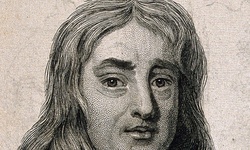Vesalius, a Scientific Approach and Civil War Doctors: William Harvey and Thomas Sydenham

Andreas Vesalius credit: Wellcome Collection)
During the Renaissance, scientific method was introduced to medicine. More doctors went to study at the universities, where new schools of medicine were founded. Here they learnt about the importance of conducting experiments, noting down their observations and drawing a conclusion. This led some doctors to discover how the Greeks and Romans had been wrong about the human body.
One of the most important people at this time was Andreas Vesalius. Vesalius was born in Brussels but went to study medicine at Louvain, Paris and then Padua. In 1537, he was made Professor of Anatomy at Padua. Vesalius promoted the study of the human body through dissection and observation. He wrote On the Fabric of the Human Body in 1543, an important work, which showed how Galen had been wrong about certain parts of the anatomy. His book included detailed illustrations drawn by artists, which enabled readers to have a more accurate picture of the body. Vesalius became doctor to Charles V of Spain and later Philip II of Spain.
Click on the images to read about some doctors in the Civil Wars who were influenced by Vesalius and the importance of scientific experiment and observation
Answer these questions
- How did the study of medicine change during the Renaissance?
- How did artists improve medical textbooks?
- Explain what was new about the work of: a) Andreas Vesalius b) William Harvey c) Thomas Sydenham
- William Harvey treated wounded soldiers at the battle of Edgehill. Use the Events page to find the names of some soldiers who were injured at this battle.
- Click here [link not yet available] to read the petition from Thomas Sydenham. What were the names of his two brothers who died fighting in the Civil Wars?


